Catalogue > List by artist
Browse the entire list of Rencontre Internationales artists since 2004. Use the alphabetical filter to refine your search. update in progress
Dustin Feneley
Catalogue : 2010Hawker | Fiction | 16mm | color | 13:15 | Australia | 2008
Dustin Feneley
Hawker
Fiction | 16mm | color | 13:15 | Australia | 2008
A travelling salesman searches for connection.
Born in Sydney, Australia in 1982, Dustin Feneley is a graduate of the Victorian College of the Arts School of Film and Television. In 2004 and 2005, he completed the Graduate Diploma and Masters of Film and Television in Narrative Directing degrees at the VCA Film School. His short films as writer and director have screened at over fifty international film festivals. At only twenty-three years of age, his student short film Snow (2005) was officially selected for competition at the 2006 Cannes Film Festival in the Cinéfondation category. The film?s selection made him the second youngest Australian director to have a film screen at Cannes in the festival?s history. Snow has also received the honour of being exhibited at the world famous George Pompidou Centre in Paris alongside other films by legendary filmmakers such as Jean-Luc Godard. Snow was awarded Best Film at the 2007 Film Fest at Falls by a highly esteemed jury of Australian film industry members including Claire Dobbin (Chair of the Melbourne International Film Festival), Antony Zeccola (Palace Films), Robyn Kershaw (Producer), and Joel Pearlman (Managing Director of Roadshow Films). His short film Apprentice has also been commercially released by Palace Films Australia as the short-before-the-feature on the popular DVD of Russian Dolls (France, 2005). Recognising his position as one of Australia?s most promising young filmmakers he was approached by the highly respected talent agency RGM Associates and is represented by RGM as a writer and director. He has directed a range of professional actors including Robert Menzies (Oscar and Lucinda, Three Dollars), Tom Budge (The Proposition, Candy) and Syd Brisbane (Boxing Day, Silent Partner). He is the winner of the 2007 Qantas Spirit of Youth Award for Moving Image, selected by veteran film director Bruce Beresford, and will undertake a mentorship with Beresford on an upcoming feature film project. In 2008 he was invited to participate in the prestigious Accelerator program of the Melbourne International Film Festival with his short film Hawker (2008). Now in its fifth year, Accelerator has firmly established itself as a showcase of pre-eminent new Australian and New Zealand shorts. For the first time featuring filmmakers from Ireland and Singapore, Accelerator has secured international recognition as an esteemed industry program. In 2008 he also worked as director?s assistant / attachment with Glendyn Ivin (2003 Palm d?Or winner for his short film Cracker Bag) on Ivin?s highly-anticipated debut feature film Last Ride, released in 2009. Feneley is currently developing his first feature film Stray.
Dustin Feneley
Catalogue : 2007Snow | Fiction | 16mm | color | 15:0 | Australia | 2005
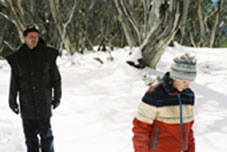
Dustin Feneley
Snow
Fiction | 16mm | color | 15:0 | Australia | 2005
"Snow" observes a boy's exploration of the thin line between life and death and his father's powerlessness to prevent his inexorable search. It is a fifteen-minute narrative short film about a twelve-year-old boy who lives alone with his father in a remote alpine environment of Australia. He experiments with the fine line between life and death by burying live rabbits in the snow and creating breathing holes for them to survive. He goes to his father to enlist him in the act of unearthing the rabbits; giving them life above ground again. He eventually makes one of the breathing holes too small. When they unearth the rabbit, it is dead. The father confronts him about his behaviour, leaving him alone in the snow with the consequences. The next morning the father wakes to find him gone. The father anxiously searches for him. Finally he discovers his son, lying on the snow, lifeless, beside a small grave for the dead rabbit.
Dustin Feneley is a recent graduate of the prestigious Victorian College of the Arts School of Film and Television in Melbourne, Australia. In 2005, he completed the Graduate Diploma of Film and Television and Masters of Film and Television (Narrative Directing) degrees at the VCA Film School. His short films, which he has written, directed and edited, have screened at over 50 international film festivals. At only twenty-three years of age, his student short film "Snow" was selected for official competition at the 2006 Cannes Film Festival. The film's selection made him the second youngest Australian director to have a film screen at Cannes in the festival's sixty-year history. He is currently writing his first feature length film "Stray".
Fenz
Catalogue : 2008Crossings | | 16mm | color | 5:0 | USA | 2006
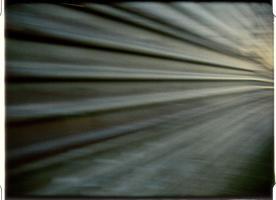
Fenz
Crossings
| 16mm | color | 5:0 | USA | 2006
In 2005, I revisited locations for a film I had worked on several years before. "Chantal Akerman?s From the Other Side" was shot along the U.S./Mexico border. "Crossings" is a short response to my experience of the shoot and its subject. A wall exists along parts of the border facing those who live on either side. The film gives multiple views of the wall and visually confronts the idea it represents. "Crossing" is a short installment of a larger project, shot in Cuba, France, the United States and Israel that investigates insularity in both geographical and cultural terms.
Robert Fenz?s body of work demonstrates an experimental, poetic approach to non-fiction filmmaking. From 1997 to 2003, Fenz worked on Meditations on Revolution, a series of short films that explore the definition of the word ?revolution.? Fenz was awarded a Guggenheim Fellowship in 2004. In 2006 he was a resident of the DAAD artist program in Berlin. Fenz currently lives in Cambridge, Massachusetts where he is making a film-portrait of author/filmmaker Robert Gardner.
Chris Ferrantello
Catalogue : 2007The Pope's Hat | Animation | dv | color | 10:30 | USA | 2006
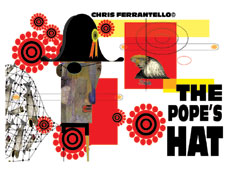
Chris Ferrantello
The Pope's Hat
Animation | dv | color | 10:30 | USA | 2006
People go crazy for the Pope's line of Hats but fights break out over who has the best hat. So there will no more Pope Hats. Is there a line of Pope Shoes in the future?
Chris Ferrantello's animation work has been shown at Sundance 2002 and 2004, Krakow 43 and 44, SeNef 2004 and 2005, Bitfilm 2003, the Viper 21 and 22 festivals, Streaming Cinema 2.0., Adobe.com, The Bit Screen and The Future Cinema show at the ZKM in Germany, and the Kiasma Museum in Helsinki. A few of his films are now distributed by RIFF (Rome Independent Film Festival). He is also a painter and editorial illustrator whose clients include Esquire magazine, MS. magazine, Travel and Leisure magazine, Sony Entertainment, The Progressive, and The New York Times, to name a few. His work has been printed in illustration annuals published by the Society of Illustrators and the design publication "Print".
Isabelle Ferreira
Catalogue : 2007Parade | Experimental video | dv | color | 1:49 | France, USA | 2005
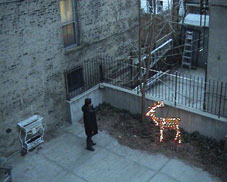
Isabelle Ferreira
Parade
Experimental video | dv | color | 1:49 | France, USA | 2005
"Parade" is a silent dialogue between two mechanisms.
Patrice Ferreira
Catalogue : 2006Septikbioethik | Experimental video | dv | color | 12:0 | France | 2003
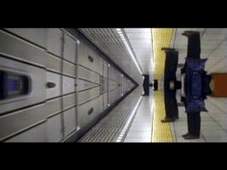
Patrice Ferreira
Septikbioethik
Experimental video | dv | color | 12:0 | France | 2003
Certain of having nothing more to do in this society, a man is wandering in subways of Tokyo. His aim : to find someone who could help him to break free out of his lot. Corridors are opening. Stations are slowly filling up. A first train is arriving. The man is walking, he looks determined. He asks to somebody : -?Excuse me, can you push me... -What do you want? I push you in a train. -No...No under...? Death could become a right, please...
Luca Ferri
Catalogue : 2022Thousand Cypresses | Experimental doc. | 0 | color | 13:0 | Italy | 2021
Luca Ferri
Thousand Cypresses
Experimental doc. | 0 | color | 13:0 | Italy | 2021
A man, inside his kitchen, is preparing his packed lunch. He has decided to visit The Brion Tomb, a monumental funeral complex, designed and built by the Venetian architect Carlo Scarpa, commissioned by Onorina Brion Tomasin, to honour the memory of the deceased and beloved relative Giuseppe Brion, founder and owner of the Brionvega company, located in the small cemetery of San Vito, in the hamlet of Altivole in the province of Treviso. Placed the food inside a polka dot plastic bag, we will find it walking inside the cemetery, observing with meticulous care the details designed by the Venetian architect, while in its silent head will resound the precious words pronounced by the architect in a conference held in the summer of 1978.
Luca Ferri (Bergamo, italy, 1976), self-taught, since 2011 has been dedicating to the writing, photography and direction of films presented to italian and international festivals, such as atlanta film festival, biografilm festival, curta cinema, documenta madrid, fidocs, filmmaker, gent international film festival, indielisboa, queer lisboa, punto de vista, pesaro film festival, cinemambiente, poff, taipei film festival, thessaloniki documentary festival, vilnius short film festival, filmer le travail, videoex and in museums and art galleries, such as spazio forma meravigli (milan), mambo (bologna), macro (rome) and schusev state museum of architecture (moscow). In 2013 the national film library of Rome organizes a restrospetictive of his works. his first feature film abacuc, released in 2015, was presented at torino film festival and mar del plata festival de cine. In 2016 colombi was presented at 73rd venice festival in the orizzonti section. In 2018 his work dulcinea was selected at 71st locarno film festival in competition in the section signs of life while pierino was presented at 61st dok leipzig. In 2020 the house of love is presented at 70th berlinale in section forum, selected to take part in the competition berlinale documentary award and receives the mention to 34th teddy awards; his work sì is presented at 77th venice international film festival, orizzonti section. In 2021 his last work a thousand cypresses was presented at 67th international short film festival Oberhausen and at the 57th mostra internazionale del nuovo cinema di pesaro. won the award for best film at the 46th laceno d'oro in the section "eyes on the city."
Aurèle Ferrier
Catalogue : 2019Transitions | Video | 4k | color | 12:48 | Switzerland | 2017
Aurèle Ferrier
Transitions
Video | 4k | color | 12:48 | Switzerland | 2017
TRANSITIONS is a journey from the civilizing void of the desert to a maximal urban, capitalistic and hedonistic density, which in the case of Las Vegas assumes some bizarre expression. The film is a contemplation without any people or moving machines in it, focussing on the built and designed.
Aurèle Ferrier (*1975 in St.Gallen, CH) lives in Zurich. With his video and cinematic works, actions and interventions he explores the margins of civilization. His works have been presented in more than 30 countries and won, among others, a Grand Jury Award at Slamdance Film Festival.
Aurèle Ferrier
Catalogue : 2026Claws | Experimental doc. | 4k | color | 18:27 | Switzerland, China | 2025
Aurèle Ferrier
Claws
Experimental doc. | 4k | color | 18:27 | Switzerland, China | 2025
CLAWS is a moving-image essay of gliding takes through rapidly expanding cities, drifting from peripheral terrains into dense cores before opening back to the horizon. In largely unpopulated frames, architecture, materials and sound turn urban expansion into a field of perception—where geometry persists, intention falters, and the land remembers.
Aurèle Ferrier is a Swiss visual artist working with film, exploring built environments and urban peripheries. CLAWS concludes his trilogy on human-made landscapes. His moving-image works have been shown at the Hiroshima City Museum of Contemporary Art (Hiroshima), IDFA (Amsterdam), Rencontres Internationales (Paris/Berlin), Open City Documentary Festival (London), Anthology Film Archives (New York) and Image Forum (Tokyo).
Markus Fiedler, Stanley Edward, Nanna Katrine Hansen, Thomas Elsted
Catalogue : 2020Cast Away Souls | Documentary | hdv | color | 34:14 | Germany | 2019
Markus Fiedler, Stanley Edward, Nanna Katrine Hansen, Thomas Elsted
Cast Away Souls
Documentary | hdv | color | 34:14 | Germany | 2019
Cast Away Souls looks at the political structures behind the conditions at the deportation centre Sjælsmark, as well as at the controversial methods used to push the centre's residents to leave Denmark voluntarily. Some call the methods inhumane, while others call them necessary. Through a conversation between the Sjælsmark unit manager Niels Johannessen and one of the residents, Stanley Edward, the film talks about everyday life under constant pressure and about a life where human rights and international conventions are put to the test. Cast Away Souls hits squarely home in one of today's great political discussions, not just about the conditions that children live in at Sjælsmark, but also more generally about human compassion and human rights at centres such as Sjælsmark.
Markus Fiedler, born 1972 in Hamburg/Germany, successfully completed his Studies of Psychology at the University of Hamburg in 2001. In addition he started the Studies of Visual Communication at the University of Fine Arts Hamburg (HfbK) between 1998 and 2003. From 2007 to 2011 he he completed the Postgraduate Studies of Audio-Visual Media / Film & TV at the Academy of Media Arts (KHM) in Cologne/Germany with his graduation film 'Elif's Boys', a 99min documentary about the story of three generations of men of a turkish-kurdish family who migrated to Germany. Since 2002 Fiedler is working as an independent filmmaker, mainly in the field of narrative documentaries. He has been working as screen printer, graphic artist and billsticker.
Andrej Filatow
Liliia Filina
Catalogue : 2026INNER IMMIGRATION | Experimental film | 35mm | color | 3:36 | Russia | 2025
Liliia Filina
INNER IMMIGRATION
Experimental film | 35mm | color | 3:36 | Russia | 2025
In a nameless Eastern European city, few young people, finds themself trapped between silent resistance and passive complicity as their country descends into war. The city’s streets, once familiar, become a landscape of fear. Shot in stark, observational style, Inner emigration is a haunting portrait of a generation suspended in stillness, forced to navigate a crumbling reality that no longer offers clear choices.
Lily Filina is an artist and director, born in Kaluga, Russia, 1999. A graduate of the Rodchenko Art School, class of Sergei Bratkov, she works as an advertising director and develops independent projects at the intersection of cinema and video art. In 2024, Liliya's film participated in the program of the Rotterdam Film Festival. In 2024, Liliya's project "Internal Emigration” was supported by the Yandex360 program.
Lina Filipovich
Catalogue : 2022So Blue | Video | mp4 | black and white | 2:26 | Belarus, France | 2021
Lina Filipovich
So Blue
Video | mp4 | black and white | 2:26 | Belarus, France | 2021
Created in collaboration with IRCAM, « So Blue » represents a false documentary on the trip of Elvis Presley to Minsk, Belarus in the 1960s. The basis and the main element of this video is a song created by me using the sound collage technique. I used a dozen fragments from different Elvis songs, changing the key, working with tempo and harmony to recreate his « unreleased song ». The lyrics were composed by the same method, using archetypal words and phrases, typical for songwriting of the 50 - 60s. The video also presents a collage made from fragments of the fictional film "I'm 20" by Marlen Khutsiev and from frames of documentary films about Minsk. This technique allowed me to create a video mystification about Elvis’s fictional travel to my hometown (Minsk). The cross between fictional and documentary cinema, between a sound collage and a false composition generates a hybrid work that provokes feelings of strangeness, deceiving the viewer about credibility of this work. This confusion gives place to the questioning from the part of the viewer concerning the documentary representation.
Lina Filipovich is an artist and musician based in Paris, France. Her works explore the relationship between audio and visuals and span a variety of media, including found footage films, experimental electronic music, painting, silkscreening and performance. Working with samples and loops, Lina Filipovich uses techniques of sound collage, musical montage, cut-up and appropriation.
Jem Finer
Catalogue : 2006The centre of the universe | Experimental video | dv | color | 5:0 | United Kingdom | 2005
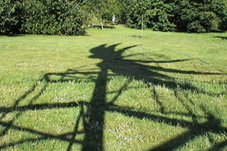
Jem Finer
The centre of the universe
Experimental video | dv | color | 5:0 | United Kingdom | 2005
In June 2005, Jem Finer built a sculptural observatory in the Oxford University Parks he called "The Center of the Universe". Made of wood and wires, this sculpture was installed in a 15 meter high spiral tower as an "radio dish" (the union between ancient observatories, the ziggurat, and the contemporaries one), in which Jem Finer lived. In this shed, the signals received from the expanse of cosmos were transcribed by an electronic equipment and an old chart recorder and then decoded into sounds. The film presented is showing a selection of the numerous timelapse films Jem Finer made during his one month stay in the park, watching the daily shadows rotating around him.
Jem Finer is an artist exploring different art fields, creating mixed up performances and installations dealing with video, music, photography, sculpture,... Most of his work concerns with extremes time and space scales as "Longplayer", a thousand year long music piece, or "Wave/particle", a film made in zero gravity exploring the quantum world. This year Jem Finer built two sculptural observatories also dealing with time and space but based these times on cosmological scales : "Landscope" in Lough Neagh, N.Ireland and "The Centre of the Universe" in Oxford, England. He recently won the PRS Foundation New Music Prize for his new musical composition called "Score for a Hole in the Ground" including wind and rain. Jim Finer is currently working on it in a forest in south east of England.
Ulrich Fischer
Catalogue : 20064 courtes pièces | Art vidéo | super8 | color and b&w | 9:5 | Switzerland | 2004
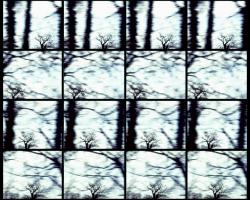
Ulrich Fischer
4 courtes pièces
Art vidéo | super8 | color and b&w | 9:5 | Switzerland | 2004
L'oeuvre d'Ulrich Fisher, les 4 courtes pièces, fait suite à une commande de la chaîne suisse alémanique SFDRS pour l`émission philosophique STERNSTUNDEN. Elle se compose de 4 clips: Ballast, Signes d´éconduite, La ville révée des grues et Mi rage. Ballast : Un quadrillage symétrique soutient et fait décoller l?image ? pas de mouvement sans ballast? Signes d´éconduite : Se laisser entraîner par des lignes fuyantes, jusqu?au point où l?espace du voyage se dissout en de multiples pistes : autant de signes qui bouclent le mouvement sur lui-même. La ville révée des grues Entre la ville cartographiée et la ville réelle, les grues ont leur mot à dire. Mirage : Que se passe-t-il quand des objets mouvants gèlent dans leur course et deviennent un solide qui marque l?espace ? On peut alors voir une sorte de mémoire d?un lieu, ce qui nous interpelle à nouer de nouvelles relations au contexte.
Né en 1971 à Genève, Ulrich Fisher réalise entre 1993 et 1996 divers films en super-8 et vidéo. Il obtient en 2000 le diplôme à l'Ecole Supérieure d'Art Visuel de Genève (ESAV). Il devient ensuite permanent au Cinema Spoutnik. Il est aussi producteur, monteur et caméraman pour Perceuse Productions.
Judy Fiskin
Catalogue : 2007The end of photography | Experimental video | super8 | black and white | 2:28 | USA | 2006
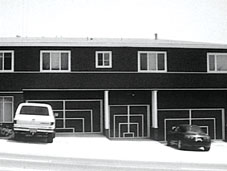
Judy Fiskin
The end of photography
Experimental video | super8 | black and white | 2:28 | USA | 2006
Black and white Super 8 images flash by as the narrator mourns the end of film photography.
Judy Fiskin is a Los Angeles based artist. She worked principally in photography from 1973-1994. In 1995, for reasons of health, she had to abandon photography and since then has been working in video and super-8 film. Her work has been shown widely in the United States and internationally, including a retrospective at the Museum of Contemporary Art in Los Angeles and a screening of her video work at the Museum of Modern Art in New York.
Tor-finn Malum Fitje
Catalogue : 2025Death Mother: As Above, So Below | Experimental film | hdv | color | 4:4 | Norway | 2024
Tor-finn Malum Fitje
Death Mother: As Above, So Below
Experimental film | hdv | color | 4:4 | Norway | 2024
This two-channel video draws its inspiration from Carl Jung's ideas of the near-death-experience, and the title refers to his archetype Death Mother. To the left you see a AI generated character dressed as an air stewardess, speaking intensely to the viewers. She has been given the deep voice of the Jungian analyst Joseph Lee. On the right screen we see real drone videos of fault ruptures caused by earthquakes, and hear sounds from inside the crust of the earth. In the vague relations between these two dream spaces - one floating on top of the other - there is a bizarre death fantasy unfolding. The underlying topic of the film can be found in the conflict between the artificial and the analogue, the vulgar and the sublime. The work won the artist BiT Elite price at Stipendutstillingen in 2024, Telemark Kunstsenter, Norway
Tor-Finn Malum Fitje is a video artist, writer and film teacher based in Oslo, Norway. He holds an MFA from the Royal Academy of Art in Stockholm, a BFA from Konstfack and a Bachelor in Film Production from Bergen University, specializing in directing. His work includes multi-channel video installations as well as feature length essay films. Malum Fitje has exhibited his films at The National Museum and Gallery of Photography in Oslo and the Museum of Modern Art in Stockholm
Catalogue : 2022Ad Nauseam: The End of Kitchen Politics | Video | mov | color | 5:13 | Norway | 2019
Tor-finn Malum Fitje, Thomas Anthony Hill
Ad Nauseam: The End of Kitchen Politics
Video | mov | color | 5:13 | Norway | 2019
The age-old dispute between the open and the closed kitchen solution have reached a dramatic climax where “The Separatists” face the “The Open Kitchen Radicals” in one final heated battle. From there the film also debates the existential properties of the bar, as in opposition to the conservative breakfast table, and attempt to explain differences in psychological temperament through people’s preferences of kitchen worktop. The End of Kitchen Politics is the second film of the umbrella project Ad Nauseam, a series of essayistic videoss portraying a society where doubt no longer exists. In this day and age, neurologists have discovered the center of consciousness, the open kitchen solution has been ruled mandatory by law, and every new parent follows the hand book How To Raise a Child obediently. While Christianity and Neo-atheism have merged to form The Faitheist Church, a universal understanding of all the rules of football have been reached. And yet, this society is permeated by a chaos so disruptive that it’s hard for people even to breathe. Through hyper stylized 3D animations and what they call “clear-cut narration”, video artist duo Tor-Finn Malum Fitje and Thomas Anthony Hill comment on the current paradigm of truth, and attempt to challenge the post-modern notion that all ways of looking at the world can be equally true.
Tor-Finn Malum Fitje (1989) was born in Porsgrunn and grew up in Bergen, Norway, where he first studied Film Production, specialising with a Bachelor’s degree in Directing. He went on to do a BFA at Konstfack, before earning his Master of Fine Arts at the Royal Institute of Art in Stockholm, graduating in 2016. Currently based in Oslo, Malum Fitjes work comprises essayistic video and audio installations, as well as text-based art. He has screened his films at the Modern Museum in Stockholm, the Gallery of Photography in Oslo and is currently working on three new films called Ad Nauseam: National Treasures Explained, that will be exhibited at the opening of the new National Museum in Oslo. Thomas Anthony Hill (1989) born in Coffs Harbor, Australia, grew up in Bergen, Norway and has lived in Oslo since 2017. In 2014 he graduated with a Master’s degree in Comparative Literature at the University of Bergen and has since then worked as a film critic and translator. Together with Malum Fitje he has created the works Hyphenic (2018) and Ad Nauseam (2020), the latter currently being exhibited at Galleri Golsa in Oslo.
Tor-finn Malum Fitje, Thomas Anthony Hill
Catalogue : 2025Death Mother: As Above, So Below | Experimental film | hdv | color | 4:4 | Norway | 2024
Tor-finn Malum Fitje
Death Mother: As Above, So Below
Experimental film | hdv | color | 4:4 | Norway | 2024
This two-channel video draws its inspiration from Carl Jung's ideas of the near-death-experience, and the title refers to his archetype Death Mother. To the left you see a AI generated character dressed as an air stewardess, speaking intensely to the viewers. She has been given the deep voice of the Jungian analyst Joseph Lee. On the right screen we see real drone videos of fault ruptures caused by earthquakes, and hear sounds from inside the crust of the earth. In the vague relations between these two dream spaces - one floating on top of the other - there is a bizarre death fantasy unfolding. The underlying topic of the film can be found in the conflict between the artificial and the analogue, the vulgar and the sublime. The work won the artist BiT Elite price at Stipendutstillingen in 2024, Telemark Kunstsenter, Norway
Tor-Finn Malum Fitje is a video artist, writer and film teacher based in Oslo, Norway. He holds an MFA from the Royal Academy of Art in Stockholm, a BFA from Konstfack and a Bachelor in Film Production from Bergen University, specializing in directing. His work includes multi-channel video installations as well as feature length essay films. Malum Fitje has exhibited his films at The National Museum and Gallery of Photography in Oslo and the Museum of Modern Art in Stockholm
Catalogue : 2022Ad Nauseam: The End of Kitchen Politics | Video | mov | color | 5:13 | Norway | 2019
Tor-finn Malum Fitje, Thomas Anthony Hill
Ad Nauseam: The End of Kitchen Politics
Video | mov | color | 5:13 | Norway | 2019
The age-old dispute between the open and the closed kitchen solution have reached a dramatic climax where “The Separatists” face the “The Open Kitchen Radicals” in one final heated battle. From there the film also debates the existential properties of the bar, as in opposition to the conservative breakfast table, and attempt to explain differences in psychological temperament through people’s preferences of kitchen worktop. The End of Kitchen Politics is the second film of the umbrella project Ad Nauseam, a series of essayistic videoss portraying a society where doubt no longer exists. In this day and age, neurologists have discovered the center of consciousness, the open kitchen solution has been ruled mandatory by law, and every new parent follows the hand book How To Raise a Child obediently. While Christianity and Neo-atheism have merged to form The Faitheist Church, a universal understanding of all the rules of football have been reached. And yet, this society is permeated by a chaos so disruptive that it’s hard for people even to breathe. Through hyper stylized 3D animations and what they call “clear-cut narration”, video artist duo Tor-Finn Malum Fitje and Thomas Anthony Hill comment on the current paradigm of truth, and attempt to challenge the post-modern notion that all ways of looking at the world can be equally true.
Tor-Finn Malum Fitje (1989) was born in Porsgrunn and grew up in Bergen, Norway, where he first studied Film Production, specialising with a Bachelor’s degree in Directing. He went on to do a BFA at Konstfack, before earning his Master of Fine Arts at the Royal Institute of Art in Stockholm, graduating in 2016. Currently based in Oslo, Malum Fitjes work comprises essayistic video and audio installations, as well as text-based art. He has screened his films at the Modern Museum in Stockholm, the Gallery of Photography in Oslo and is currently working on three new films called Ad Nauseam: National Treasures Explained, that will be exhibited at the opening of the new National Museum in Oslo. Thomas Anthony Hill (1989) born in Coffs Harbor, Australia, grew up in Bergen, Norway and has lived in Oslo since 2017. In 2014 he graduated with a Master’s degree in Comparative Literature at the University of Bergen and has since then worked as a film critic and translator. Together with Malum Fitje he has created the works Hyphenic (2018) and Ad Nauseam (2020), the latter currently being exhibited at Galleri Golsa in Oslo.
Scott Fitzpatrick
Catalogue : 2017Screen Test 1 (Self-portrait) | Experimental film | 16mm | color | 2:30 | Canada | 2015
Scott Fitzpatrick
Screen Test 1 (Self-portrait)
Experimental film | 16mm | color | 2:30 | Canada | 2015
Laser-printed onto recycled 16mm film in 2015.
S.F. is a visual artist (Libra) from YWG, whose film and video work has screened at underground festivals and marginalized venues worldwide. He studied film theory and production at the University of Manitoba, and began conducting lo-fi moving image experiments in 2010. Primarily a filmmaker, also invested in photography, re-photography, kaleidoscope and collage. In addition to producing his own work, S.F. presents the work of others through the Winnipeg Underground Film Festival and Open City Cinema.
Catalogue : 2016Immortal Cats #1 | Experimental film | 35mm | color | 0:55 | Canada | 2015
Scott Fitzpatrick
Immortal Cats #1
Experimental film | 35mm | color | 0:55 | Canada | 2015
What is your greatest ambition in life? Laser-printed onto recycled 35mm film in 2015.
S.F. is a visual artist (Libra) from YWG, whose film and video work has screened at underground festivals and marginalized venues worldwide. He studied film theory and production at the University of Manitoba, and began conducting lo-fi moving image experiments in 2010. Primarily a filmmaker, also invested in photography, re-photography, kaleidoscope and collage.
Frode Fjeringstad
Catalogue : 2013Irene in the Poconos | | | color | 1:0 | Norway | 2011
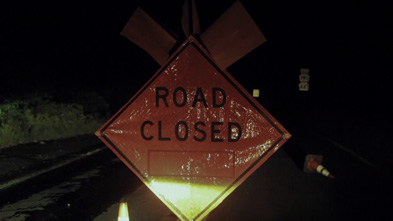
Frode Fjeringstad
Irene in the Poconos
| | color | 1:0 | Norway | 2011
THE FILM WAS SHOT IN THE POCONOS IN PENNSYLVANIA USA WHEN HURRICANE IRENE WAS HAMMERING AROUND. Early on August 27, Irene further weakened to a Category 1 hurricane as it approached the Outer Banks of North Carolina. At 7:30 am EDT (11:30 UTC) the same day, Irene made landfall near Cape Lookout, on North Carolina's Outer Banks, with winds of 85 mph (140 km/h). After having tracked over land for about 10 hours, the eye of Irene became cloud-filled, although the center remained well-defined on radar images. Later on August 27, Irene re-emerged into the Atlantic near the southern end of the Chesapeake Bay in Virginia. Shortly before sunrise, at about 09:35 UTC on August 28, Irene made a second landfall at the Little Egg Inlet on the New Jersey shore with winds of 75 mph, and soon after moved over water again. Hours later, Irene weakened to a tropical storm with winds of 65 mph (100 km/h) near New York City.
Frode Fjerdingstad (born 1975) is a photographer, born in Oslo, Norway. He studied photography at the London College of Printing. Frode has exhibited his work at the National Artcenter Tokyo and at several other occasions in London, Oslo, Zürich.
Andrea Flamini
Catalogue : 2006Impromptu no. 3 | Art vidéo | dv | color | 1:31 | Italy, USA | 2004
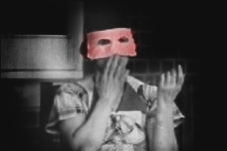
Andrea Flamini
Impromptu no. 3
Art vidéo | dv | color | 1:31 | Italy, USA | 2004
In Impromptu no. 3, the apparently calm--yet maniacally repetitive--gesture of caressing one`s own face is intensified through the use of a mirror image. The fragmented movements of the mirrored video provide for deeper character analysis, and suggest an even more distressed state of being. Through the use of synch scripts the mirrored video image has been manipulated, from the original medical research footage of a mental sanatorium, to expose a more accurate `psychological reality` of the patient. Thus obtaining, through manipulation, a perhaps more accurate representation of the patient?s feeling than what the documentary source material has hoped for.
Born in Rome, Italy, Andrea Flamini currently resides in Kansas City, Missouri USA, where he is Assistant Professor in the Photo and New Media Dept. at the Kansas City Art Institute. Flamini`s installations generate cinematic environments that test our perception of memory, space and narrative. In his database narratives, short tales of conflict and resolution are developed with infinite variations that resist the conventional narrative logics of cause and effect. Flamini`s work is exhibited at media festivals, galleries and museums in the U.S. and abroad.